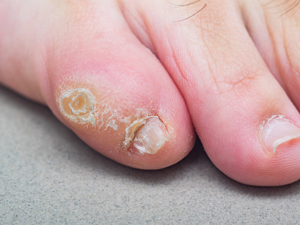Corns
What is a Corn?
Corns are dense ball-shaped patches of dead skin cells and can occur in many different areas on the foot. There are three types of corns that are most often seen in clinic;
● hard corn
● soft corn
● seed corns
A hard corn usually occurs on the underside of your foot as well as the tops and tips of your toes. Hard corns, as the name suggests, are thicker and denser.
A soft corn is whitish in appearance and occurs between the toes, normally between the fourth and fifth. The surface of a soft corn is much thinner and more rubbery in its presentation.
Finally the seed corn is the smallest in size and is often seen on the ball of your foot, sometimes between the skin creases of your big toe joint and the second toe joint. Seed corns usually appear in clusters and can cause a burning type sensation.
Hard and soft corns on the other hand (or foot!) cause more of a sharp pain that increases over time if left untreated.
So, what causes corns?
Rubbing, friction and mainly pressure are the reasons for corns developing and reoccurring. Anything that increases this friction and pressure will increase your risk of developing corns.
Ill fitting or tight fitting footwear is the main contributing factor and that is why women are more likely than men to develop corns.
Research tells us that most women wear shoes 2 sizes too small while mean wear them 1 size too big. High heeled footwear puts immense pressure, rubbing and friction on all different areas of the foot so if worn on a regular basis the chances of the corn returning, even after treatment, is very very likely.
Other causes include foot deformities such as bunions and hammer toes.
It is very common to have a corn present on a bunion due to the rubbing and pressure of the bunion within the shoe.
Hammer toes usually lead to corns developing on the top of your toes if there is not enough depth in the toe box of the patient’s shoe. During summertime even wearing slip on sandals can lead to additional friction and pressure on your feet, resulting in corns and foot calluses.
How do I treat my corn?
Corn removal is a simple and should be a pain free way of immediately relieving yourself of the corn. Padding can then be applied around the corn to give the area relief when going back into footwear for the following day or two.
For more tricky corns between or around the toes, a custom wedge device can be made in clinic to wear whilst in footwear to offload areas of high pressure/rubbing.
There are many treatments offered in other outlets, one that mainly sticks out is the use of corn pads. Corn pads have a dose of acid within the plaster that aims to dislodge the corn so it may fall out.
Unfortunately, too often as foot health practitioners we have seen the acid cause harm to healthy surrounding tissues with not much success in treating the corn itself. As a result we strongly recommend you do not use corn plasters to help avoid ulceration.
How can you prevent corns from recurring?
To prevent corns from coming back, the most important step is to wear well-fitting shoes with adequate room in the toe box, along with cushioned socks, and regularly inspect your feet for early signs of pressure points; you can also use padding like moleskin or corn pads on areas prone to corns, and maintain good foot hygiene by moisturizing regularly and filing down rough skin with a pumice stone.
Key points to prevent corns:
· Proper footwear:
· Choose shoes that fit well and have enough width in the toe box.
· Avoid high heels and tight, pointy shoes.
· Consider shoes with a soft sole and good cushioning.
· Replace shoes regularly as they wear down.
· Foot care routine:
· Wash your feet daily with soap and water.
· Dry your feet thoroughly, especially between toes.
· Apply moisturizer regularly to keep skin soft.
· Use a pumice stone or foot file to gently remove dead skin.
· Trim toenails straight across.
· Padding and protection:
· Use moleskin or corn pads on areas where pressure builds up.
· Consider custom orthotics to redistribute pressure on your feet.
· Wear cushioned socks to reduce friction.
· Lifestyle changes:
· Avoid standing or walking for long periods without breaks.
· Change your shoes throughout the day to prevent constant pressure
on the same spots.
· Consult a foot health practitioner if you have recurring corns or underlying foot problems

